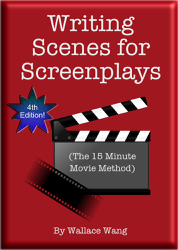Everyone has an idea for a screenplay (especially in Los Angeles). The problem is that ideas are easy but turning an idea into a full-length, formatted screenplay is hard. So the answer is simple. Don’t waste time writing full-length, properly formatted screenplays.
If you want to sell a screenplay, you’ll eventually have to write a full-length, properly formatted screenplay, but don’t worry about that just yet. After all, a properly formatted screenplay is useless if the story that screenplay tells is flawed, dull, boring, or forgettable.
Hollywood is full of properly formatted screenplays thanks to screenwriting word processors like Final Draft. Formatting a screenplay should be the least of your worries. In the beginning, you should always focus on creating a compelling story because if you can’t tell an interesting story, all the proper formatting won’t matter.
Step #1: Tell an Interesting Story
Every good story is about solving an inner and an outer problem. The inner problem is what your hero needs to learn to change into a better person. The outer problem is what forces your hero into facing their inner problem.
In “Die Hard”, the outer problem is how can the hero, John McClane, defeat an army of terrorists single-handedly? However, the inner problem is will John McClane realize his own arrogance threatens to break up his marriage?
Notice that the outer problem alone (fighting an army of terrorists single-handedly) must be interesting and compelling on its own. If your hero’s outer problem is not interesting, you don’t have a story.
In “The Hunger Games”, the outer problem is how can the hero, Katniss Everdeen, survive a deadly reality TV contest? However, her inner problem is learning that she can be likable.
In “Up”, the outer problem is how can the hero, an older man named Carl, deal with old age alone after losing his wife? However, his inner problem is needing to learn to keep living and seek out new adventures.
So the hero’s outer problem is what defines an interesting story. In “Die Hard”, the idea of one man fighting an army of terrorists alone is pretty clear. Yet in “Up”, the idea of a bitter old man trying to deal with old age is more abstract and vague. That makes the story of “Up” much harder to sell than an action story like “Die Hard”. In general, the more visually active your story, the easier it will be to sell.
Step #2: Give Your Story an Emotional Heart
Your hero’s outer problem is what we see. Your hero’s inner problem is their flaw that’s created an emotional block in the hero’s life. Until the hero can remove this emotional block, their life can never be better. This inner, emotional problem gives meaning to your story.
In “The Shawshank Redemption”, take away the hero’s need to cling to hope and the entire outer problem of the story can remain the same but suddenly pales in significance because it doesn’t mean anything any more.
In “Legally Blonde”, strip away the hero’s need to become a strong, independent woman and you simply have a far less interesting story about a young woman trying to win back her boyfriend.
In “Die Hard”, take away the hero’s need to change and become a better person and you wind up with the outer plot problems of all those poor “Die Hard” sequels.
When creating your own story, make sure your hero’s outer problem directly challenges your hero’s inner problem. In “The Shawshank Redemption”, the hero, Andy, clings to hope. Therefore throughout most of the story he’s stuck in a prison where there’s no hope he’ll ever get out.
In “Legally Blonde”, the hero, Elle, needs to become a strong, independent woman. Yet her whole goal in chasing after her boyfriend to law school is to become subservient to him.
In “Die Hard”, the hero, John McClane, needs to realize his arrogance broke up his relationship with his wife. Yet he believes the army of terrorists are what really is keeping him from his wife. Physically, the terrorists are keeping John McClane from his wife, but it doesn’t matter because if John McClane never changes, the terrorists could go away and he’ll still be unable to get along with his wife.
When looking at your hero’s inner, emotional problem, always look at how the story setting needs to make the hero’s inner problem as hard as possible to achieve.
Step #3: Summarize Your Story
Once you understand that a compelling story is both what we see (the hero’s outer problem) along with what the hero needs to overcome to become a better person (the hero’s inner problem), start making up your story as plain text in an ordinary word processor. The goal is to write and condense your story so you can show it to others and get them excited about how it turns out.
When you create a compelling story, converting it into a full-length, formatted screenplay is easy. If you’re like most people and try to make up your story while formatting it at the same time, you’re going to create a mess that you’ll likely never fix.
Always focus on telling an interesting story first. Then focus on writing it as a properly formatted screenplay. That’s the secret to writing better screenplays.
Sign up to take a FREE course about how to write scenes in a screenplay.

